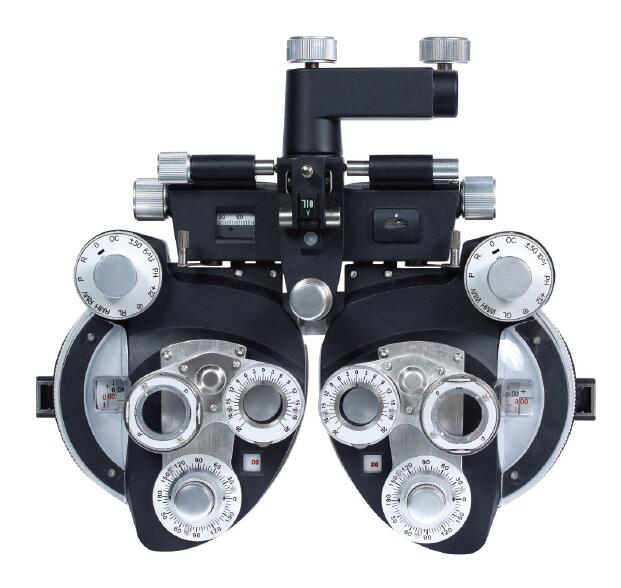The structure of a comprehensive refractometer
The comprehensive refractor is mainly composed of two parts, one is the test disc (commonly known as "lung head" and "bull's eye"), and the other part is the optotype, which is divided into two parts: far use and near use.
Inspection CD
The inspection disc consists of 5 parts, which are the viewing hole, the main lens group, the built-in auxiliary lens, the external auxiliary lens and the adjustment parts.
Sight hole
The eye to be tested is observed through the sight hole. A cylinder axis scale is attached to the periphery of the sight hole, which is convenient for adjusting the axis when using a crossed cylinder lens (below).
Main lens group
The main lens group includes a spherical lens and a cylindrical lens (below).
①Spherical lens: -20.00D~+20.00D, fine adjustment can be adjusted by 0.25D each time, and coarse adjustment can be adjusted by 3.00D each time.
②Cylinder lens: 0D~-6.00D, each adjustment changes 0.25D. The axial direction is 0°~180°.
Built-in auxiliary mirror
The built-in auxiliary lens is a functional lens that transforms both eyes into the same or a group of lenses every time they rotate one gear (the picture below).
External auxiliary mirror
The external auxiliary mirror is composed of a cross cylindrical mirror and a rotating prism
①Cross cylindrical lens: used when accurately adjusting the axis and luminosity of the cylinder, including two important positions, namely point A and point P. Point A is the position that needs to be aligned with the original cylinder axis when adjusting the axis. Point P is the position where the axis of the cylinder lens needs to be aligned when adjusting the luminosity.
②Rotating prism: According to the position of 0, the base orientation of the rotating prism can be adjusted to four directions up, down, inside and outside, and the size of the prism can be adjusted at the same time.
Adjustment parts
①Vertical balance handwheel: adjust so that the optical center of the sight lens is vertically aligned with the center of the pupil of the tested eye;
②Optical distance handwheel: adjust the customer’s interpupillary distance;
③Forehead rest handwheel and lens eye distance reading window: adjust the distance between the measured eye and the sight lens;
④ Set switch: Adjust the opening and closing degree of the test disc so that the optical center distance of the visual aperture lens corresponds to the distance between the pupils of the tested eye.

Thanks for time waiting.
Sophie Yang
004@mikeoptical.com

